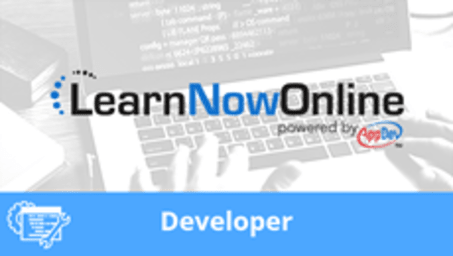
Microsoft LINQ Using Visual Basic 2010, Part 2 of 4
Course description
In this course, you will learn to use the Language Integrated Query (LINQ) to easily create complex data-independent queries. In addition, you will learn about the language features for Visual Basic in Visual Studio 2010 in order to make LINQ possible. You will start by working through a quick overview of LINQ, and how it applies to working with collections of objects, retrieving data stored in SQL Server, and creating XML content. Subsequent topics introduce new LINQ-oriented language features, LINQ to Objects, LINQ to DataSets, LINQ to SQL, LINQ to XML, and LINQ to Entities. By the time you have completed the course, you will have a good understanding of now only how to construct LINQ queries to work with data, but also how to use the features added to Visual Basic that support LINQ.
Each LearnNowOnline training course is made up of Modules (typically an hour in length). Within each module there are Topics (typically 15-30 minutes each) and Subtopics (typically 2-5 minutes each). There is a Post Exam for each Module that must be passed with a score of 70% or higher to successfully and fully complete the course.
Prerequisites
This course assumes that students have familiarity with .NET in general, and with specifically with programming ADO.NET. The course makes no attempt to explain basic Visual Studio 2010 or .NET Framework concepts, and assumes that the student is at least familiar with all the concepts covered in the Introduction to Programming and Developing Applications with Visual Studio 2010 courses.
Meet the experts
Ken Getz
Ken Getz is a featured instructor for several of our Visual Studio courses. He is a Visual Basic and Visual C# expert and has been recognized multiple times as a Microsoft MVP. Ken is a seasoned instructor, successful consultant, and the author or co-author of several best-selling books. He is a frequent speaker at technical conferences like Tech-Ed, VSLive, and DevConnections and he has written for several of the industry's most-respected publications including Visual Studio Magazine, CoDe Magazine, and MSDN Magazine.
Robert Green
Robert Green is a Visual Studio expert and a featured instructor for several of our Visual Basic and Visual C# courses. He is currently a Technical Evangelist in the Developer Platform and Evangelism (DPE) group at Microsoft. He has also worked for Microsoft on the Developer Tools marketing team and as Community Lead on the Visual Basic team. Robert has several years of consulting experience focused on developer training and is a frequent speaker at technology conferences including TechEd, VSLive, VSConnections, and Advisor Live.
Video Runtime
178 Minutes
Time to complete
218 Minutes
Course Outline
Module 3
LINQ And Collections (23:58)
- Introduction (00:45)
- What Can You Query? (00:31)
- Arrays (00:14)
- Different Types of Objects (00:17)
- Arrays of Different Types (01:08)
- Using the Let Keyword (00:34)
- Using the OfType Method (01:40)
- Demo: Query an Array (03:29)
- Generic Lists (00:31)
- Extension Methods (00:27)
- Query Sytax vs. Functional (02:04)
- Generic Dictionaries (00:31)
- Demo: Lists and Dictionaries (04:39)
- Strings (00:25)
- Non-Generic Collections (01:46)
- Demo: Strings & Non-Generic (04:10)
- Summary (00:42)
LINQ Extension Methods (17:12)
- Introduction (01:10)
- Working with Data (00:52)
- Demo: Setup (03:05)
- Creating Sequences (00:26)
- Selecting Sequences (00:54)
- Retrieving a Single Element (02:43)
- Demo: Creating Sequences (01:32)
- Demo: Selecting Sequences (01:30)
- Demo: Single Elements (04:00)
- Summary (00:55)
More LINQ Extension Methods (37:08)
- Introduction (00:35)
- Filtering Sequences (01:10)
- Demo: Filtering (02:24)
- Ordering Sequences (00:31)
- Verifying Sequences (01:29)
- Demo: Ordering & Verifying (08:10)
- Converting Sequences (00:45)
- Positioning within Sequences (00:43)
- Demo: Converting & Positioning (06:16)
- Calculating Sequences (00:53)
- Demo: Calculating (04:07)
- More Complex Calculations (00:19)
- Sample Calculation (01:18)
- Demo: Aggregate Methods (04:31)
- Set Operations (00:47)
- Demo: Set Operations (02:31)
- Summary (00:31)
Module 4
Mapping Data To Objects (19:30)
- Introduction (01:10)
- LINQ to SQL (00:55)
- Mapping Data to Objects (01:12)
- DataContext Class (01:04)
- Entity Class (00:43)
- Relationships (01:50)
- Create an Object Model (00:52)
- Demo: O/R designer (11:18)
- Summary (00:23)
Querying Data (30:21)
- Introduction (00:25)
- Querying with LINQ to SQL (01:05)
- Generated SQL Statements (01:42)
- Simple Queries (01:23)
- Using Scaler Functions (00:59)
- Using Aggregate Functions (00:50)
- Demo: Simple Queries (10:46)
- Demo: Scaler Functions (01:02)
- Demo: Aggregate Functions (04:12)
- Querying Related Tables (02:00)
- Demo: Related Tables (05:32)
- Summary (00:20)
More Querying Data (23:47)
- Introduction (00:26)
- Lambda Expressions (01:15)
- Extension Methods (00:53)
- Demo: Lambda Expressions (04:04)
- Demo: Extension Methods (03:02)
- Grouping (00:50)
- Joins (01:28)
- Demo: Grouping (07:25)
- Demo: Joins (03:51)
- Summary (00:30)
Modifying Data (26:46)
- Introduction (00:35)
- Overview (01:32)
- Demo: Modifying Data (01:55)
- Demo: Add a Customer (03:28)
- Demo: Delete a Customer (03:36)
- Stored Procedures (01:05)
- Demo: Stored Procedures (08:39)
- Demo: Configure Behavior (04:03)
- Summary (01:50)







